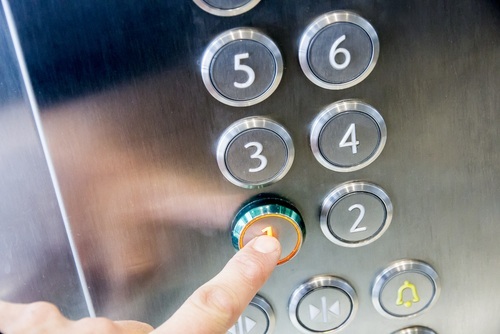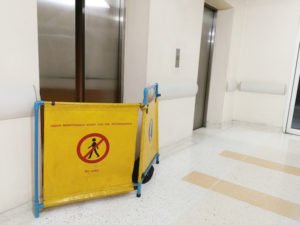Under most state personal injury laws, if you are injured in an elevator accident, you can file a lawsuit against those responsible for causing the accident. The amount of the settlement or verdict can range from a few thousand dollars to over a million dollars, depending on the extent of the injuries and the degree of negligence that led to the accident.
A personal injury lawsuit allows you and your families to seek a money settlement, including compensation for:
The parties who might be responsible for an elevator accident can include the:
- Elevator manufacturer;
- Elevator maintenance company; or
- Property owner or manager.
If someone is killed in an elevator accident, a wrongful death lawsuit will allow the family to get compensation for the loss of a loved one.
Our elevator accident attorneys discuss the frequently asked questions about elevator accidents:
- 1. Can I file a lawsuit after an elevator accident?
- 2. Who is responsible for a fatal elevator accident?
- 3. What sort of settlement can I obtain?
- 4. Can I sue for getting stuck in an elevator?
- 5. Is the building owner responsible?
- 6. Is the elevator company responsible for an elevator-related injury?
If you have further questions after reading this article, we invite you to contact us at Shouse Law Group.

If you are the victim of an elevator accident, you may be able to file a personal injury lawsuit seeking damages.
1. Can I file a lawsuit after an elevator accident?
If you suffer an injury from an elevator accident you can file a personal injury lawsuit. A personal injury lawsuit allows you to sue for damages caused by the accident. The parties responsible for the accident, or “defendants” may be liable for damages.
Liability in an elevator accident depends on who is considered to be responsible for the accident. Most elevator accident claims are based on:
There are many parties involved in
- operating,
- maintaining,
- or designing elevators.
If you are injured in an elevator accident, the negligent party may be held liable for your financial losses and noneconomic damages. In elevator accident lawsuits, the defendants may include:
- Property owner;
- Elevator maintenance company;
- Engineer;
- Architect;
- Building maintenance company;
- Elevator manufacturer;
- Elevator seller; or
- Elevator company employee.
Even if you were partly responsible for causing the accident, you may still be able to claim damages from the defendants. Under California’s “comparative fault” law, you are able to recover damages based on each party’s level of fault. 1
Demonstrating Negligence
Most personal injury claims are based on a negligence cause of action. To show the defendant was negligent, you have to prove:
- The defendant(s) owed you a duty of care;
- The defendant(s) breached the duty of care through negligent action or inaction; and
- The defendant’s negligence was a substantial factor in causing the harm or death.2
In some cases, an employee may be responsible for causing the accident but does not have enough money to cover your damages. However, under “Respondeat Superior” laws, the employer may be liable for an employee’s negligence.3
Example: Cameron works for Rusty’s Elevator Maintenance. He tried fixing an apartment building elevator, but it was still a couple inches from level with the floor when the doors opened. He decided to quit for the day when a resident tripped on it and hit her head. Under California’s vicarious liability laws, Rusty’s Elevator Maintenance may be liable for Cameron’s negligence.
2. Who is responsible for a fatal elevator accident?
The same parties who may be responsible for an elevator injury may also be liable for a fatal elevator accident. When an elevator accident results in someone’s death, the surviving family members may be able to file a wrongful death claim.
A wrongful death lawsuit allows certain family members to seek compensation when a loved one is killed in an accident. Whoever was responsible for causing the fatal accident, including the
- manufacturer,
- property owner, or
- elevator service company, is liable for damages.4
Damages in a wrongful death lawsuit are different than those available in a personal injury lawsuit. In a wrongful death claim, damages are for the loss to the family members related to the death of a loved one, including:
- Funeral and burial costs;5
- Loss of financial support;6
- Loss of service;7
- Loss of companionship;
- Loss of support; and
- Loss of affection.
Not all family members can file a wrongful death lawsuit. Family members who can file a wrongful death lawsuit in California include:
- Spouses or domestic partners;
- Surviving children;
- Grandchildren (if there are no surviving children); or
- Anyone else who has a claim under California intestate succession laws.
Example: The property manager of a building turns off the wrong elevator, causing the engineer working in the building to fall to her death. A jury finds the property manager liable and awards the engineer’s spouse and children damages that include funeral costs, the loss of earnings the engineer would have brought to the family, and an award for the loss of support the spouse and children would no longer have.
3. What sort of settlement can I obtain?
In a personal injury lawsuit, you sue the defendant for “damages” related to the accident. The elevator accident lawsuit settlement may account for the financial losses suffered by you as well as compensation for noneconomic harm. These compensatory damages may include:
- Medical bills,
- Physical therapy,
- Long-term care,
- Medication and medical supplies,
- Lost wages,
- Loss of future income,
- Loss of consortium,
- Injury to reputation,
- Emotional distress, and
- Pain and suffering.

There are several possible at-fault parties following an elevator accident.
4. Can I sue for getting stuck in an elevator?
One of the most common problems people face is getting stuck in an elevator. In most cases, getting stuck in an elevator does not result in any harm or injuries. However, in some cases, getting stuck in an elevator may lead to physical or emotional harm that could justify a personal injury lawsuit.
Under California law, you can file a claim for negligent infliction of emotional distress. If you suffer emotional distress as the result of an elevator accident, you may be eligible for damages from the party responsible.
You are considered the direct victim of negligent infliction of emotional distress if you suffered serious emotional distress as a result of the defendant’s negligence.8 “Serious emotional distress,” may be found where a reasonable person would be unable to adequately cope with the mental stress under the circumstances.9
Example: A building manager flips the wrong breaker and the elevator stops, causing Annie who is trapped inside to panic until she is discovered the next morning. Here, Annie has decent grounds to sue the building manager for negligent infliction of emotional distress. Getting stuck in an elevator overnight may be difficult for an ordinary person to handle mentally.
5. Is the building owner responsible?
Under premises liability laws, a property owner or occupier may be liable for accidents that occur on their property. Property owners owe a duty of care to others, including visitors and customers. Property owners have to keep the property safe from dangerous conditions.
Under California premises liability laws, you must prove the following:
- The defendant owned, occupied, or controlled the property;
- The defendant was negligent in the use or maintenance of the property;
- You were harmed;
- The defendant’s negligence was a substantial factor in causing your harm.10
When an elevator accident occurs, the building owner may be liable to you if the building owner was negligent in the use or maintenance of the property.
Example: Scott owns a small office complex and manages the property himself. One day Tina takes the elevator when the doors close on her, breaking her arm. Since Scott is responsible for the property, he may be liable for Tina’s injuries if a jury determines Scott was negligent in maintaining the property.
Note that a tenant may be able to sue a landlord for elevator injuries that occur at an apartment building.
6. Is the elevator company responsible for an elevator-related injury?
The elevator manufacturer may be liable for a defective elevator even if no individual at the elevator company was negligent. Under California’s products liability laws, whoever designs, manufactures, or sells a defective product is strictly liable for injuries caused by that product.11
The elevator company may be responsible for a defective elevator or elevator part based on the following types of defects:
Example: Sherman Trees Building Supply Company sells Brutus brand elevators. After an elevator malfunctions and causes injuries, an engineering expert finds the accident was caused by a Brutus manufacturing defect. Under California product liability laws, Sherman Trees may still be liable for the accident even though they were unaware of the defect.
Legal References:
- California Civil Jury Instructions (CACI) 405. See also California Civil Jury Instructions (CACI) 406. (“… you must then decide how much responsibility each has by assigning percentages of responsibility to each person listed on the verdict form. The percentages must total 100 percent.”)
- California Civil Jury Instructions (CACI) 400. See also California Civil Code section 1714(a) (“Everyone is responsible, not only for the result of his or her willful acts, but also for an injury occasioned to another by his or her want of ordinary care or skill in the management of his or her property or person.”)
- Perez v. Van Groningen & Sons, Inc. (1986) 41 Cal.3d 962, 967 (“Under the doctrine of respondeat superior, an employer is vicariously liable for his employee’s torts committed within the scope of the employment.”)
- California Code of Civil Procedure 377.60 (“A cause of action for the death of a person caused by the wrongful act or neglect of another may be asserted by any of the following persons or by the decedent’s personal representative on their behalf: (a) The decedent’s surviving spouse, domestic partner, children, and issue of deceased children, or, if there is no surviving issue of the decedent, the persons, including the surviving spouse or domestic partner, who would be entitled to the property of the decedent by intestate succession.”)
- Vander Lind v. Superior Court (1983) 146 Cal.App.3d 358.
- See Allen v. Toledo (1980) 109 Cal.App.3d 415.
- See California Civil Jury Instructions (CACI) 3921.
- See California Civil Jury Instructions (CACI) 1620. (Negligent Infliction of Emotional Distress—Direct Victim—Essential Factual Elements).
- Molien v. Kaiser Foundation Hospitals (1980) 27 Cal.3d 916.
- California Civil Jury Instructions (CACI) 1000. Premises Liability. Essential Factual Elements.
- Soule v. GM Corp. (1994) 8 Cal.4th 548, 560 (“A manufacturer, distributor, or retailer is liable in tort if a defect in the manufacture or design of its product causes injury while the product is being used in a reasonably foreseeable way.”)
- See CACI Series 1200 — Products Liability.
